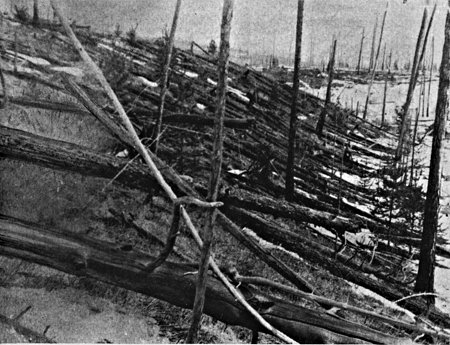The Tunguska Event was loud and destructive, one of the largest and loudest explosions in recorded history.
The explosion occurred on the morning of June 30, 1908, in a remote region of Russia, near the Podkamennayta Tunguska River. The explosion levelled 830 square miles of forest, knocking down tens of millions of trees in a pattern that looked from the air to some observers like a  butterfly’s wingspan. At the center of the blast zone, trees were standing but were missing their branches. Some estimates put the force of the explosion at the equivalent of an earthquake measuring 5.0 on the Richter scale. Other estimates are that the blast had a force of several dozen of the atomic bombs that exploded over Japan near the end of World War II. (These atomic blasts also resulted in large numbers of branchless trees.)
butterfly’s wingspan. At the center of the blast zone, trees were standing but were missing their branches. Some estimates put the force of the explosion at the equivalent of an earthquake measuring 5.0 on the Richter scale. Other estimates are that the blast had a force of several dozen of the atomic bombs that exploded over Japan near the end of World War II. (These atomic blasts also resulted in large numbers of branchless trees.)
Eyewitnesses dozens of miles away reported seeing a huge light moving across the sky and then sounds of an explosion. Descriptions of the celestial body differed, with some witnesses reporting seeing ash clouds and red flames and white cloudy trails. Most people who saw it said that the “it” was a big rock that was there in the sky for about 10 minutes before it disappeared from view.
Many people far from the blast site felt the shockwaves and a fierce, hot wind. Forest workers reported being blown off their feet, in some cases straight into trees. One man 40 miles away from the blast center said he was thrown from his chair and got so hot that he felt his shirt was on fire. In settlements 50 miles away, windows shattered and crockery fell off shelves. People 300 miles away reported hearing a deafening bang.
Known fatalities include many animals and a few humans.
 Because of the remoteness of the areas, not much was known about the event until 1927, when a high-profile group funded by the Soviet government and led by noted scientist Leonid Kulik trekked to the Tunguska area to investigate. (Kulik had led an earlier expedition into the area but was thwarted by the harshness of the Siberian wilderness.)
Because of the remoteness of the areas, not much was known about the event until 1927, when a high-profile group funded by the Soviet government and led by noted scientist Leonid Kulik trekked to the Tunguska area to investigate. (Kulik had led an earlier expedition into the area but was thwarted by the harshness of the Siberian wilderness.)
One thing that Kulik’s team did not find was a giant impact crater. The scientists found large holes in the ground and concluded that these must be smaller meteoric craters. Supporting evidence for that hypothesis wasn’t readily available, however.
Kulik led several more investigations into the area and turned up unusual amounts of metals and other elements consistent with an impact event. But again, the scientific teams found no conclusive proof.
In 1930, a British astronomer, F.J.W. Whipple, put forward the theory that the Tunguska event was caused by the explosion of a comet, the dust and ice of which would have been vaporized on impact with Earth’s atmosphere, thus creating no impact and, therefore, no impact crater. That idea gained support in the Russian scientific community in the next few decades.
Italian scientists in 2007 reported finding evidence to support the idea that a lake in the area, now called Lake Cheko, was the suspected impact crater and that it had filled in with water during the years since the blast occurred.
More recently, investigations have turned up evidence that could support the atmospheric meteoric explosion theory. Among the phrases used were “a ball of fire” and “a flying star with a fiery tail.” Each of those phrases could describe a meteor or a comet. Overall, however, scientists still don’t agree on what happened that day in 1908.